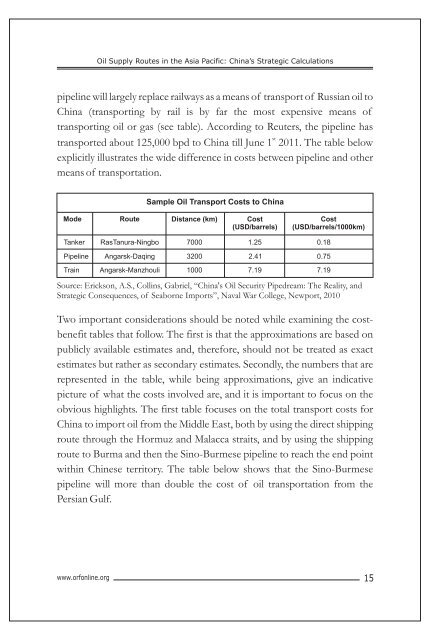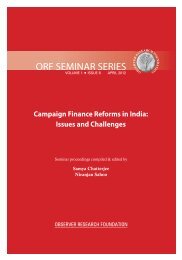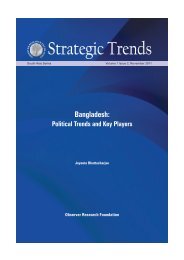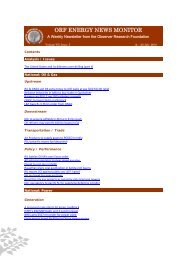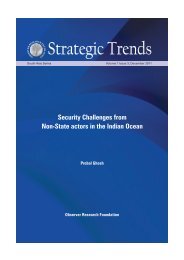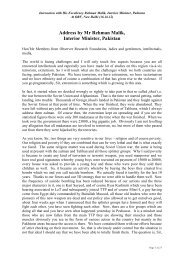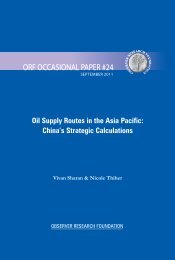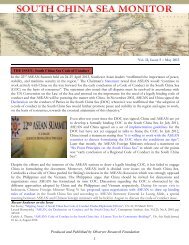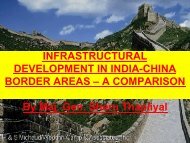Oil Supply Routes in the Asia Pacific: China's Strategic Calculations
Oil Supply Routes in the Asia Pacific: China's Strategic Calculations
Oil Supply Routes in the Asia Pacific: China's Strategic Calculations
Create successful ePaper yourself
Turn your PDF publications into a flip-book with our unique Google optimized e-Paper software.
<strong>Oil</strong> <strong>Supply</strong> <strong>Routes</strong> <strong>in</strong> <strong>the</strong> <strong>Asia</strong> <strong>Pacific</strong>: Ch<strong>in</strong>a’s <strong>Strategic</strong> <strong>Calculations</strong><br />
pipel<strong>in</strong>e will largely replace railways as a means of transport of Russian oil to<br />
Ch<strong>in</strong>a (transport<strong>in</strong>g by rail is by far <strong>the</strong> most expensive means of<br />
transport<strong>in</strong>g oil or gas (see table). Accord<strong>in</strong>g to Reuters, <strong>the</strong> pipel<strong>in</strong>e has<br />
st<br />
transported about 125,000 bpd to Ch<strong>in</strong>a till June 1 2011. The table below<br />
explicitly illustrates <strong>the</strong> wide difference <strong>in</strong> costs between pipel<strong>in</strong>e and o<strong>the</strong>r<br />
means of transportation.<br />
Sample <strong>Oil</strong> Transport Costs to Ch<strong>in</strong>a<br />
Mode Route Distance (km) Cost<br />
(USD/barrels)<br />
Cost<br />
(USD/barrels/1000km)<br />
Tanker RasTanura-N<strong>in</strong>gbo 7000 1.25 0.18<br />
Pipel<strong>in</strong>e Angarsk-Daq<strong>in</strong>g 3200 2.41 0.75<br />
Tra<strong>in</strong> Angarsk-Manzhouli 1000 7.19 7.19<br />
Source: Erickson, A.S., Coll<strong>in</strong>s, Gabriel, “Ch<strong>in</strong>a's <strong>Oil</strong> Security Pipedream: The Reality, and<br />
<strong>Strategic</strong> Consequences, of Seaborne Imports”, Naval War College, Newport, 2010<br />
Two important considerations should be noted while exam<strong>in</strong><strong>in</strong>g <strong>the</strong> costbenefit<br />
tables that follow. The first is that <strong>the</strong> approximations are based on<br />
publicly available estimates and, <strong>the</strong>refore, should not be treated as exact<br />
estimates but ra<strong>the</strong>r as secondary estimates. Secondly, <strong>the</strong> numbers that are<br />
represented <strong>in</strong> <strong>the</strong> table, while be<strong>in</strong>g approximations, give an <strong>in</strong>dicative<br />
picture of what <strong>the</strong> costs <strong>in</strong>volved are, and it is important to focus on <strong>the</strong><br />
obvious highlights. The first table focuses on <strong>the</strong> total transport costs for<br />
Ch<strong>in</strong>a to import oil from <strong>the</strong> Middle East, both by us<strong>in</strong>g <strong>the</strong> direct shipp<strong>in</strong>g<br />
route through <strong>the</strong> Hormuz and Malacca straits, and by us<strong>in</strong>g <strong>the</strong> shipp<strong>in</strong>g<br />
route to Burma and <strong>the</strong>n <strong>the</strong> S<strong>in</strong>o-Burmese pipel<strong>in</strong>e to reach <strong>the</strong> end po<strong>in</strong>t<br />
with<strong>in</strong> Ch<strong>in</strong>ese territory. The table below shows that <strong>the</strong> S<strong>in</strong>o-Burmese<br />
pipel<strong>in</strong>e will more than double <strong>the</strong> cost of oil transportation from <strong>the</strong><br />
Persian Gulf.<br />
www.orfonl<strong>in</strong>e.org 15


